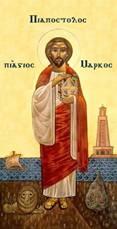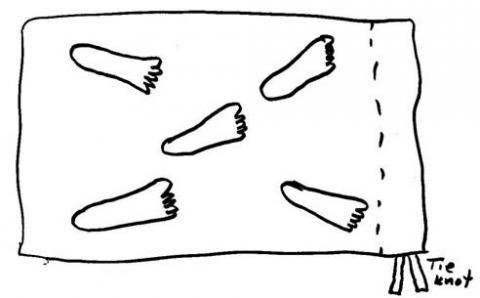Egypt: St. Mark of Alexandria
ST. MARK OF ALEXANDRIA
 Objectives:
Objectives:
- Students should be able to identify Mark as the writer of the Gospel of Mark, written with St. Peter.
- Students should know that Mark went with Paul and Barnabas on their first journey, but went home partway through
- Students should identify St. Mark as the first bishop of Alexandria in Egypt.
Possible Lesson Plan:
- Open with prayer.
- Tell the story of St Mark; have ready the pictures of Holy Thursday and of Paul’s first missionary journey from their Bible storybooks:
St. Mark, author of the Gospel that bears his name, is met in the Scriptures with his Jewish name of John, meaning “Yahweh has shown grace”. “Marcus”, while a common Roman name, is an unusual name to find in a Jewish household; it is unclear where this name came from. In many early writings, John Mark bears the nickname, “stumpy-fingered”, possibly due to a physical peculiarity.
John Mark’s mother, Mary, was related to Barnabas, the wealthy landowner of Cyprus, who later became an apostle. Mary, a widow, was a woman of wealth and position in Jerusalem and a follower of Jesus. We meet John Mark in the Garden of Gethsemane as the young man wearing only a linen cloth who, when he was grabbed by the men arresting Jesus, fled naked.
John Mark’s home was a meeting place of the early Christians. In fact, when St. Peter was released from prison in Acts 12, he knows exactly where to go to find the Church. He is met there by the maidservant of the house and left standing on the doorstep until she tells the Christians inside, who joyfully let Peter in.
John Mark remained at home in Jerusalem until he was brought to Antioch by Barnabas and Paul. He traveled with the two to Cyprus on their first missionary journey. But, when the group reached Perga in Asia Minor, John Mark left them and returned to Jerusalem. Paul viewed this as desertion and refused to take John Mark with them on the second missionary journey. Barnabas separated from Paul and took John Mark with him to Cyprus and Paul traveled with Silas. Later, we find John Mark with Paul the prisoner in Rome, past history apparently forgiven. Paul sends Mark on several missions, first to Colossae and later, with Timothy to Asia Minor.
Mark was also a companion and helper of the Apostle Peter in his journeys. While Mark was with Peter in Rome, the faithful asked him to write down for them the life and miracles of the Lord Jesus and Mark wrote carefully that which Peter had witnessed. Peter chose Mark to preach the Gospel in Egypt, and Mark became the first bishop of Egypt. He taught in Pentapolis and then in Alexandria, where he founded a goodly church with priests and deacons. Mark’s teaching in Egypt was confirmed with many miracles. Finally, the pagans brought accusations against Mark and he had to flee back to Pentapolis. He spent two years in Pentapolis, where he continued his earlier work. After two years, Mark returned to Alexandria, to the great joy of the church there, which was growing mightily. But the pagans seized Mark and dragged him over the cobblestones to prison. An angel appeared to Mark in prison and then Jesus Himself appeared and said, “Peace to thee, Mark My Evangelist!” On the next day, the pagans dragged Mark through the streets until, bloody and injured, Mark went home to his Lord. His relics were buried by the Christians and have throughout the ages brought healing to many believers.
- Mark was all over! Review the stories of the major players in his life – Jesus at the Garden of Gethsemane, Peter being freed from prison, Paul and his first journey with Barnabas, Peter in Rome. But, finally, Mark was all grown up and was sent all by himself to teach the people of Egypt about Jesus. Review the stories of Egypt, especially Joseph and Moses. Egypt has figured heavily in history. Joseph and Mary even took the baby Jesus there to keep him safe from King Herod. Pictures of all of these events are in the students’ Bible storybooks. Look at pictures of Egypt – the pyramids, the Sphinx were all there when Mark was alive and are still there today! Mark ended his life as a martyr; do the students remember the meaning of “martyr”? Can they name some other martyrs? Who was the first martyr?
- Play a Guessing Game: Choose people from the life of St. Mark (e.g., Jesus, Barnabas, Paul, Peter) Write their names on slips of paper. A student draws a slip of paper. He begins to give clues to the other students, the goal being to make it as hard as possible for them to guess who he is. For example, beginning with “I am a man.” Then, “I am Jewish.” Etc. See how far he can get before the class guesses his identity.
 Make Mark’s traveling bag: Mark would definitely need a traveling bag; he went everywhere. Trace his journeys on a map if you want. What would he pack? Take a pillowcase. Cut a small section of the hem at the open end and insert a piece of clothesline or similar rope. Thread it through to close the bag and carry it. On one side, write with permanent marker, St. Mark’s Traveling Bag. Put on a smock (available in classroom) Now take off your shoes! Have each student dip his foot in paint (not too much!) and make footprints on the other side of the bag. Use acrylic paint so it will be permanent. Let dry till next week and take home.
Make Mark’s traveling bag: Mark would definitely need a traveling bag; he went everywhere. Trace his journeys on a map if you want. What would he pack? Take a pillowcase. Cut a small section of the hem at the open end and insert a piece of clothesline or similar rope. Thread it through to close the bag and carry it. On one side, write with permanent marker, St. Mark’s Traveling Bag. Put on a smock (available in classroom) Now take off your shoes! Have each student dip his foot in paint (not too much!) and make footprints on the other side of the bag. Use acrylic paint so it will be permanent. Let dry till next week and take home.
- Close with prayer: Lord, make Me your obedient and good traveler, going wherever You need me as did St. Mark.